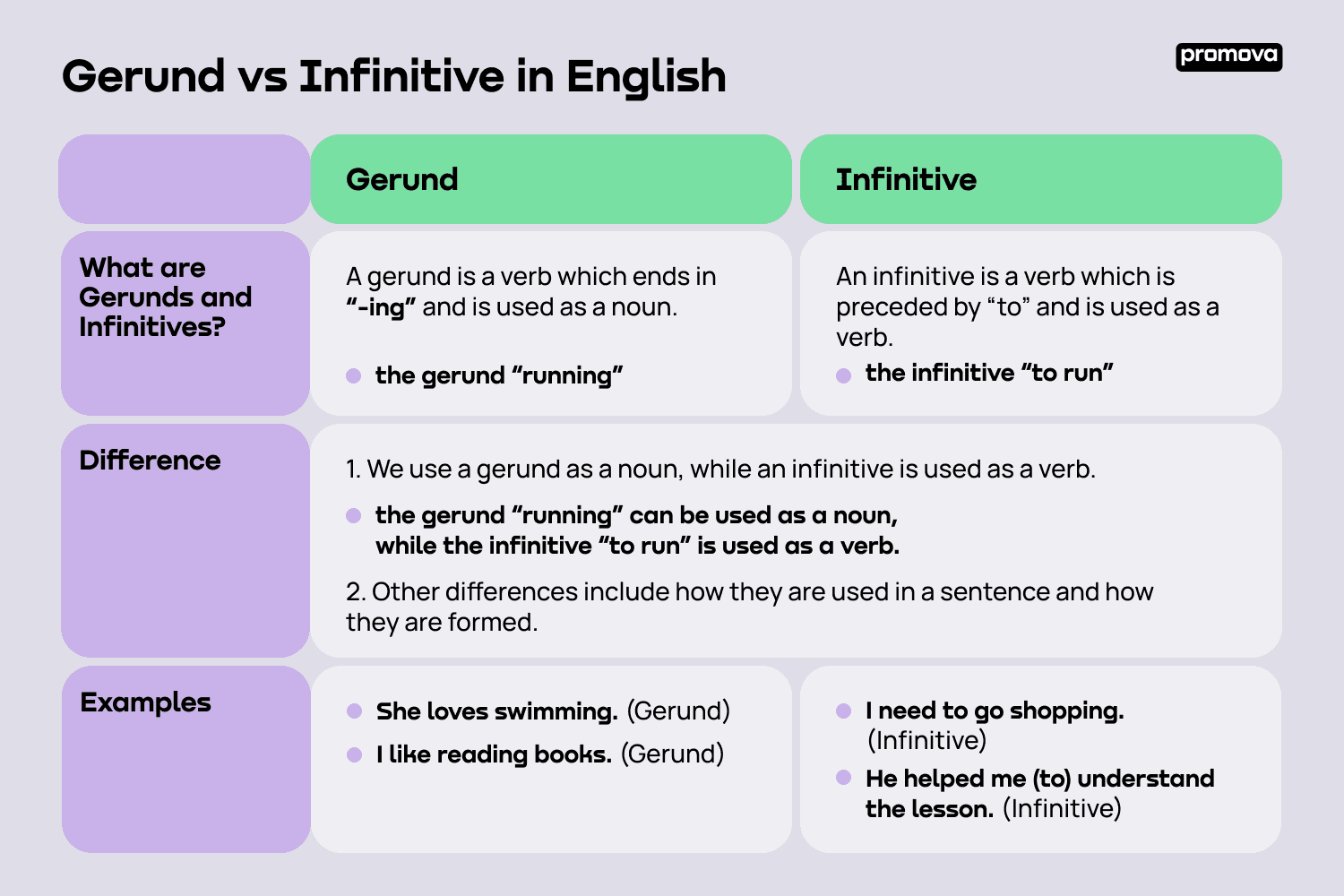Gerund vs Infinitive in English
Contents
English grammar can be a tricky subject and one of the trickiest things to master is the use of gerunds and infinitives. If you’re looking to improve your English in this area, you’ve come to the right place.
In this reference, we’ll be discussing the differences between gerunds and infinitives, their uses, common mistakes, and some rules for using them correctly. Let’s start learning!
What are Gerunds and Infinitives?
Gerunds and infinitives are two of the most common verb forms in English. A gerund is a verb which ends in -ing and is used as a noun. An infinitive is a verb which is preceded by “to” and is used as a verb. For example, the gerund “running” and the infinitive “to run” are both forms of the verb “run.”
Difference Between Gerund and Infinitive
The difference between gerunds and infinitives is that we use a gerund as a noun, while an infinitive is used as a verb. For example, the gerund “running” can be used as a noun, while the infinitive “to run” is used as a verb. Other differences include how they are used in a sentence and how they are formed. 
Uses of Gerunds and Infinitives
Gerunds and infinitives can be used in a variety of ways in a sentence. A gerund can be either the object or the subject of your sentence, while an infinitive can be used as the main verb in a sentence. For example, the gerund “running” can be used as the subject of the sentence “Running is my favorite exercise,” and the infinitive “to run” can be used as the main verb in the sentence “I like to run every morning.”
Gerunds and infinitives can also be used after certain verbs or adjectives. For example, the verb “enjoy” is usually followed by a gerund, as in “I enjoy running,” and the adjective “hard” is usually followed by an infinitive, as in “It’s hard to run.”
Verbs Followed by Gerunds Only
Certain verbs are always followed by a gerund. These include verbs expressing preference or enjoyment, such as “enjoy” and “admit,” and verbs related to starting, continuing, or stopping an action, such as “finish” or “delay," and some mental verbs: consider, imagine, suggest, recommend, mind, forget.
For example, “I enjoy running” and “We began learning French last year.”
Verbs Followed by Infinitives Only
Certain verbs are always followed by an infinitive. These include verbs of obligation, such as “need” and “must,” as well as verbs of influence, such as “help” and “threaten.” For example, “I need to run” and “She threatened me to open the door.”
You can also try making more complex sentences like “She helped me to understand the lesson.”
1
Verbs Followed by Both Gerunds and Infinitives
Finally, certain verbs can be followed by either a gerund or an infinitive. These include verbs of preference, such as “prefer” and “like,” and verbs of perception, like “see," "hear," and “smell.” For example, “I regret speaking like that” and “I like running.”
Common Mistakes with Gerunds and Infinitives
One of the most common mistakes with gerunds and infinitives is using the wrong form. For example, using the wrong verb form after a verb of perception. can change the meaning of a sentence.
- Infinitive (without "to") emphasizes a completed action witnessed.
- I saw him jump over the fence. (I saw the entire action of him jumping)
- We heard them argue all night. (We heard the whole argument unfold)
- Gerund (-ing form) emphasizes an action in progress at the time of perception.
- I saw him jumping on the trampoline. (I saw him while he was jumping)
We heard them arguing as we walked by. (We heard the argument happening as we passed by)
- I saw him jumping on the trampoline. (I saw him while he was jumping)
Rules for Using Gerunds and Infinitives
There are a few rules to help you remember when to use a gerund or an infinitive.
- Verbs expressing preference or enjoyment are usually followed by a gerund, while verbs of obligation and influence are usually followed by an infinitive.
- Modal verbs, helping verbs "let" and “make” are always followed by infinitives.
- Verbs of perception can be followed by either a gerund or an infinitive.
Examples of Gerunds and Infinitives
Here are some examples of gerunds and infinitives in use:
- I need to go shopping. (Infinitive)
- She loves swimming. (Gerund)
- He decided to take a break. (Infinitive)
- I like reading books. (Gerund)
- He helped me (to) understand the lesson. (Infinitive)
Summary
We use gerunds as a noun, while an infinitive is used as a verb. They both can help your speech in a variety of ways in a sentence, depending on the verb or adjective in the sentence.
With practice and a bit of patience, you can master the use of these parts of grammar and improve your English!



Comments